Menu
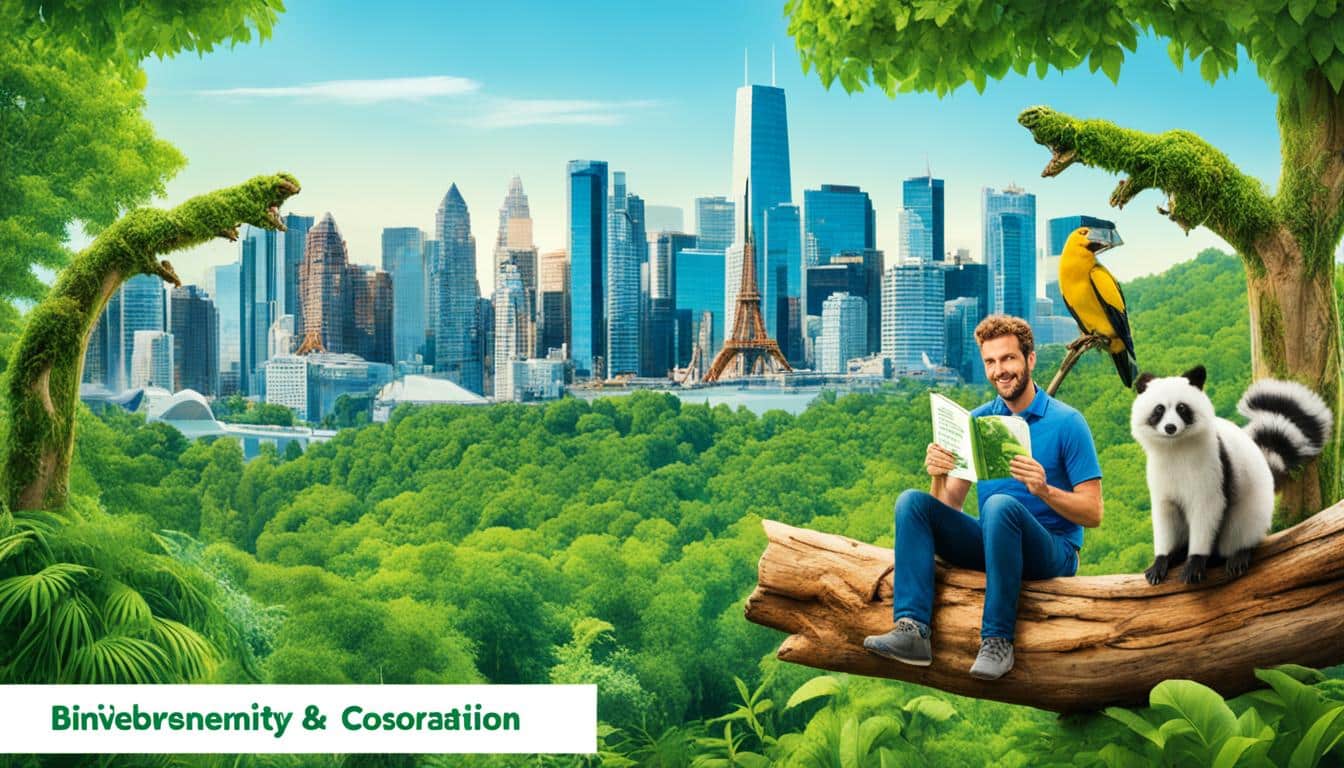
When I sit in a sunlit forest or see a bird soar, I’m reminded of biodiversity’s deep impact. It’s crucial for our survival, not just a range of species and bright ecosystems. Biodiversity ensures everything from clean air to fresh water that we need. Yet, it’s facing serious threats.
Our actions, like clear-cutting forests, polluting, and overfishing, are pushing species towards extinction fast. But, there’s hope through education. In Washington state, a huge $23 million was set aside for the Biodiversity Initiative. This showcases a major step in the right direction.
Before this, 95% of 268 species in dire need of help didn’t get enough support. Now, thanks to this funding, the Marine Coastal Flyway project and similar efforts can do more. They will help educate people on why we should conserve biodiversity.
This push in Washington is part of a global movement. Organisations like the IUCN and the World Environmental Education Congress lead the way. They’re changing how we teach to inspire the next wave of eco-champions. They run green learning programs and eco-workshops.
Biodiversity is the wide array of life on Earth. It includes genes, ecosystems, and cultural processes. It is crucial for our very survival. Learning about biodiversity through nature preservation courses and wildlife protection classes helps us see the deep connections between nature and society.
Teaching about biodiversity empowers people to become guardians of the environment. These teachings show why it’s vital to live in harmony with nature. They also highlight the many ways biodiversity helps us, such as through food, shelter, and maintaining our climate.
Many dangers threaten biodiversity, like habitat loss and pollution. Education focused on preserving biodiversity has become essential for our future. Places like the Center for Biodiversity and Conservation (CBC) in Vietnam offer great training. They use modern tools to better protect wildlife.
By joining nature preservation courses, wildlife protection classes, and sustainable development seminars, we equip ourselves for the fight against biodiversity loss. This type of learning encourages us to take actions. Examples include creating protected zones, restoring lands, and pushing for better policies.
So, biodiversity education has never been so important. It helps us address the major environmental challenges we face. By supporting these educational efforts, we can make a real difference. We inspire a new wave of environmental stewards. They are ready to preserve the amazing life on our planet.
Environmental education is key to supporting sustainable development. It teaches us about our environment and how we affect it. This knowledge helps us make smart choices for the planet’s future.
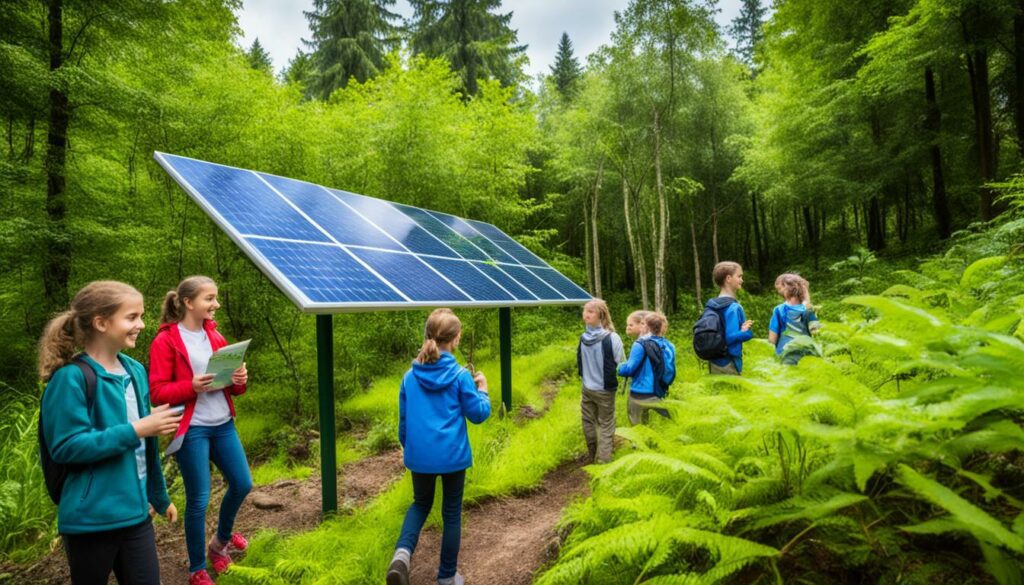
Teaching the importance of caring for our planet is crucial for its future. Studies show that well-educated people see climate change as a major problem. Education makes a big difference in how we view the environment.
Groups like the Climate Action Network work together worldwide to fight environmental harm. The WWF and other charities also play a big role. They hold events where people learn how to protect nature better.
Teaching about biodiversity helps make students more conscious of the environment. Teachers can use great resources from places like Kids.Earth.Org and NASA. These tools make learning engaging and informative.
By including these resources in lessons, we build a deep understanding of saving our planet. This method shows students the links between nature and our actions.
Year of Publication: 1996
Number of pages in the document: 42
Descriptors: Case Studies, Change Strategies, Consciousness Raising, Conservation (Environment), Elementary Secondary Education, Environmental Education, Nonformal Education, Science Education, Sustainable Development, Technological Advancement
Available from: Academy for Educational Development
Green education projects, like the GreenCOM Project, are a success. They’re backed by the U.S. Agency for International Development. These projects help make learning about the environment more effective.
| Resource | Description | Accessibility |
|---|---|---|
| Kids.Earth.Org | Diverse environmental teaching materials for young learners | Free |
| NASA’s Vital Signs of the Planet | Scientific data and research on climate change | Free |
| WWF’s Science that Affects Our World | Insights on global conservation efforts | Free |
| British Council’s Climate Resources for School Teachers | Comprehensive climate education resources | Free |
By using these teaching tools, we help students become leaders in protecting the planet. They will be ready to face environmental challenges confidently.
Global initiatives play a key role in promoting biodiversity conservation education. They bring people together to take action and introduce new, creative teaching methods. These efforts help build a worldwide community dedicated to saving our natural world.
The World Environmental Education Congress (WEEC) is a major event, gathering experts from everywhere to talk about and improve green education efforts. It serves as a hub for exploring new ways to teach about protecting nature and using eco-friendly ways to learn. WEEC deals with the changing needs of teaching the environment, connecting educators globally to promote sustainable actions.
Nature-based Education (NbE) mixes learning about the environment with practical, outdoor activities. This method makes learning more enjoyable and deepens our link to nature. NbE highlights the importance of green education by combining knowledge of nature with personal development. It helps students recognise how they can learn and act in ways that are good for the planet. By involving people emotionally and practically, NbE helps create a new wave of eco-conscious individuals.
| Initiative | Focus Areas | Impact |
|---|---|---|
| WEEC | Environmental Education, Sustainable Development | Global Networking, Transformative Approaches |
| NbE | Outdoor Learning, Socio-emotional Growth | Enhanced Ecological Literacy, Personal Growth |
Studying successful efforts in biodiversity conservation worldwide shows us what works. It underlines the crucial part focused actions play in keeping ecosystems healthy.
Washington State’s Biodiversity Initiative takes a broad view on saving nature. It combines educational strategies and wildlife protection. Plus, it gets a lot of money to manage habitats and watch over the animals.
This project focuses on keeping areas like Coasts and Puget Sound safe, bringing back plants in the Shrub-Steppe, and teaching about fish and wildlife. It shows how looking at the whole picture can make a big difference.
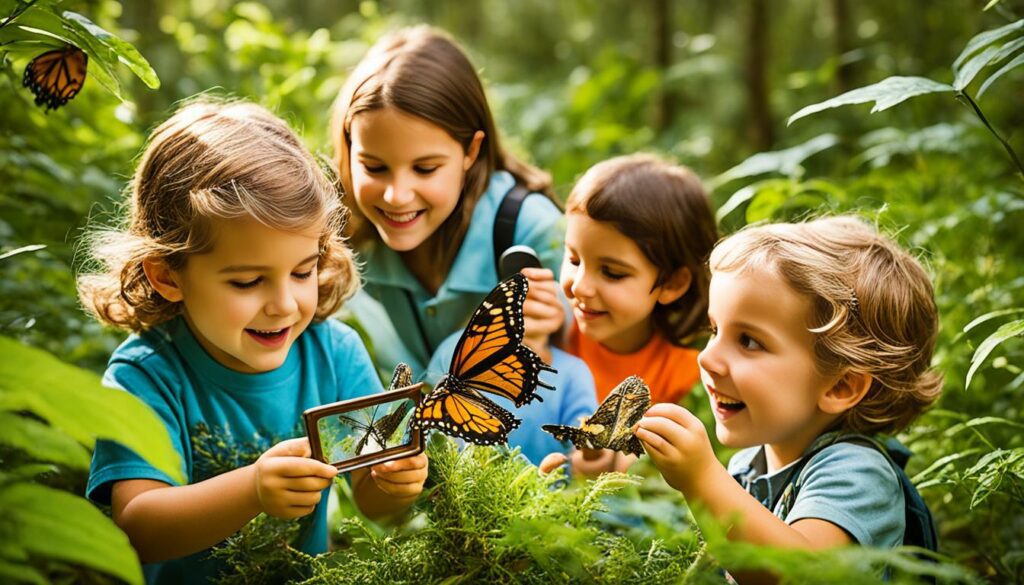
The project works closely with local groups to teach people about caring for nature. By joining these efforts with school and community programs, Washington State is making sure young people learn how to protect the world they live in.
Audubon Washington’s projects highlight the value of hands-on nature work and special learning events. They’re deeply into protecting bird species and their homes. They also team up with people to get everyone involved in looking after nature.
They teach about big issues like how climate change affects nature up close and why we need to be careful with our actions. Their wildlife protection classes are key in telling everyone how they can help different types of wildlife and their homes. This makes a real difference in nature and gets more people to care about saving it.
Both Washington State’s Biodiversity Initiative and Audubon Washington do a lot to help our planet stay strong. They show how a mix of learning and doing stuff directly can really change the game for our world’s creatures and plants.
Community engagement is now key in conserving nature, especially where wildlife is rich. In the last 50 years, experts found working with locals helps a lot. This led to many projects involving people in protecting nature, from teaching to hands-on work.
The Integrated Conservation and Development Programs (ICDPs) are a major way to bridge nature goals with local needs. Started 30 years ago, they’ve grown and changed to tackle new issues. In places like East Africa, they’ve shown how working with communities can benefit nature.
Communities can get involved by joining environmental workshops and local projects. Being part of nature’s protection changes how they think and act. This helps keep the efforts going and makes people feel responsible for the environment.
Now, more land is protected globally, thanks to people joining in. Many methods are used to get communities involved, ensuring conservation works well. From teaching at schools to running workshops, the message gets across to everyone.
Experts check how well these community projects help nature. Their findings guide future plans, making it easier to link nature with community needs. The aim is to build a balance where both nature and people can grow without harm.
It’s critical to make nature preservation studies both meaningful and effective. I’m focusing on creating nature preservation courses and programmes that are both structured and smart. These will help anyone learn about and work towards saving our planet.
A good conservation biology course mixes practical work, theory, and research chances. This makes it easier for students to get why ecosystems and biodiversity are vital. For example, the work done at the Center for Conservation Initiatives (CCI) in Florida is a great guide. They offer hands-on work and classes, showing the deep connection between theory and practice.
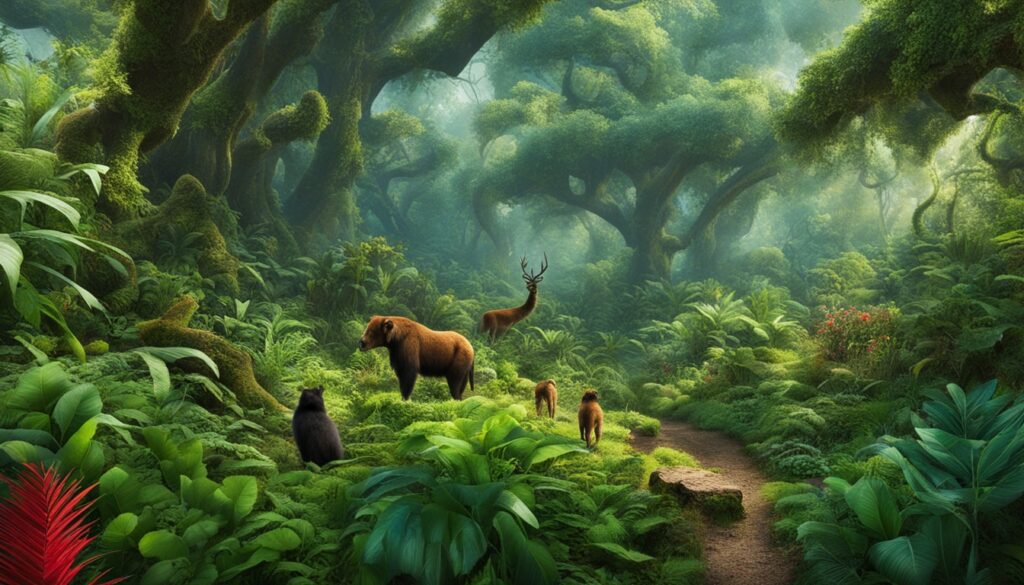
The work at places like CCI’s Apalachicola Bluffs, Blowing Rocks, and more shows how different areas meet different educational needs. They work with places like Archbold Biological Station and Bok Tower Gardens. This teamwork teaches us the value of joining up to teach about nature.
To create eco-friendly learning programmes, we need to include green practices in schools. This means using materials that don’t harm the planet and saving energy. It also means learning outside. These steps make students love and respect nature more.
Countries and areas across the world, from Haiti to Florida in the US, can all make strong nature preservation courses and wildlife protection classes. Doing this in many places means more people get to learn how to look after our planet.
Online platforms and courses have a big role to play in green education, just like what CCI is doing. They allow for more people to join in, from everywhere. This way, more folks can get involved in caring for our planet.
Conservation workshops and seminars are key for spreading knowledge on how to protect wildlife and nature while helping communities grow sustainably. These meetings bring together experts, officials, teachers, and everyone interested. They share important information and work out ways to tackle big environmental problems.
Today, the world is seeing a big drop in the number of different animals and plants. Since 1970, global populations of mammals, birds, fish, reptiles, and amphibians have fallen by 69%. This information comes from the WWF, known for protecting nature. Also, in the US, 40% of animal species are in danger. Protecting our environment is now more crucial than ever.
Such events help educate and push for policies that make a real difference. Nearly 35% of plant species are under threat, which puts the natural balance we all rely on in danger. And did you know, about one-third of our food crops require animals to help pollinate them? This shows how vital biodiversity is to our food and livelihoods.
Another exciting benefit is the chance to create jobs. By focusing on saving our natural habitats, these events could help make 20 million new jobs around the world. Plus, there are already about 75 million jobs in similar areas. This not only helps the planet but also boosts the economy.
Biodiversity is worth more than $150 trillion each year. That’s more than what all countries produce together. The loss of natural areas affects businesses, leads to higher costs, and can stop the production of goods. Therefore, learning about conservation through workshops and seminars is vital for everyone.
Also, consumers care more and more about how companies protect the environment. Getting involved in conservation doesn’t just help nature. It also makes companies look good in the eyes of their customers. Being eco-friendly is good for business and the planet.
There are efforts in towns, too, like the Inner City Youth Institute and the Duwamish Valley Youth Corps. These groups are teaching young people to care for nature. They show how hands-on work can make a big difference. Workshops and seminars are key in training our future nature protectors.
Schools play a vital role in teaching students to care for the environment. They use innovative ways to make kids love conservation.
Making school areas green helps not only with looks but also with teaching conservation. Kids can plant native species, make wildlife-attracting gardens, and set up composting. They learn why biodiversity is crucial by working in projects that better their local area.
A global survey of 10,000 children revealed only 9% prioritised environmental activities over other pastimes, highlighting the necessity of promoting biodiversity awareness within the school system.
In Michigan, even five-year-olds help in a plant greenhouse and follow endangered plants. This makes learning about wildlife protection real and meaningful for young ones.
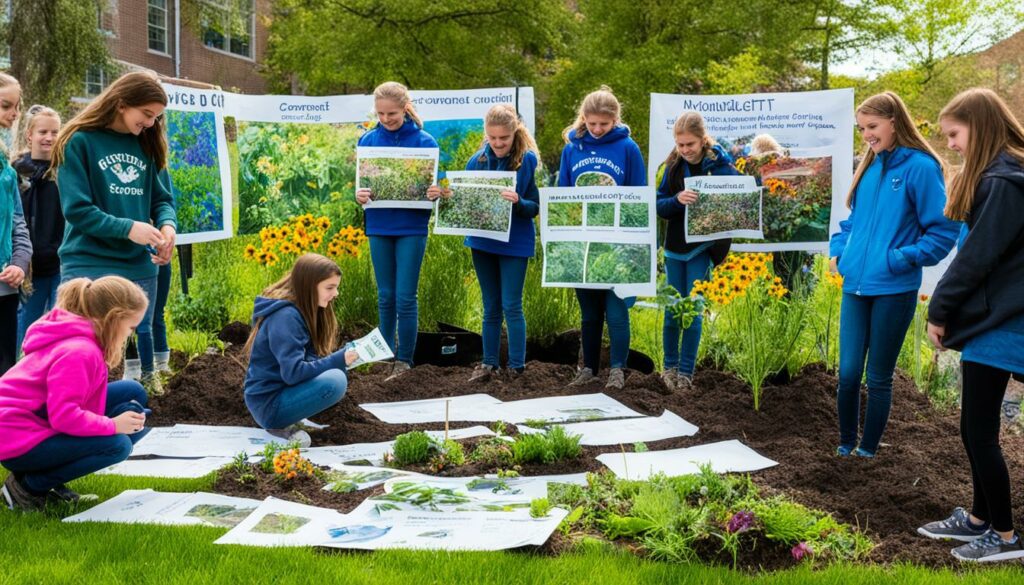
Getting out of classrooms into nature is a big plus. 30% of kids love being outside, but many also like computer games. Teaching conservation outdoors makes it more fun and effective.
Pushpa Gujral Science City had online meetings with 300 people to talk about biodiversity. Seeing real examples and practical lessons make students more committed to saving nature.
Getting nearly half of the world’s young people involved in protecting the Earth can make a big difference. Schools are key in preparing future leaders in wildlife protection. They inspire kids worldwide to care for our planet.
Today’s wildlife protection classes are key in educating a new generation. They teach the value of conservation and how to get involved. By using fun, interactive ways and technology, these classes make learning exciting. This helps students understand the complex ideas of protecting wildlife.
Interactive learning is at the heart of successful wildlife classes. They use games, virtual simulations, and real-life eco-challenges to spark interest. These methods get students involved in saving nature. They include hands-on projects and going into the field. Through these, students learn in a tangible way, making them care deeply about wildlife protection.
Using the latest tech is vital in teaching about nature. Virtual reality, apps, and online sites can make learning about wildlife more fun and effective. These tools create experiences that show why saving wildlife is so important right now.
AZA-accredited zoos and aquariums are doing a lot to educate people. They teach more than 180 million visitors and 51 million students about wildlife each year. They have also trained over 400,000 teachers with educational material on protecting animals. This includes award-winning content on conservation. Education Advisors from AZA play a key role in teaching and reaching out to the public.
| Program | Participants | Key Activities |
|---|---|---|
| Canopy Connections | Hundreds of 6th and 7th graders | Learning about forest ecology |
| Inner City Youth Institute (ICYI) | Approximately 100 students | Teaching forest ecology and stewardship |
| Duwamish Valley Youth Corps (DYVC) | 250+ students | Helping to plant trees in local areas |
| STEM High School Field Study | 700 students and 9 teachers | Conducting research at Mount St. Helens |
By blending interactive methods with technological tools, wildlife protection classes provide a dynamic and effective learning environment. These innovative approaches not only teach but also motivate students. They encourage young people to actively safeguard our planet. This helps secure a future where biodiversity thrives.
Sustainable development seminars are key in making future environmental leaders. They give insight into ecological challenges and how to solve them. These events push for a fair way that helps people and the planet, without hurting biodiversity.
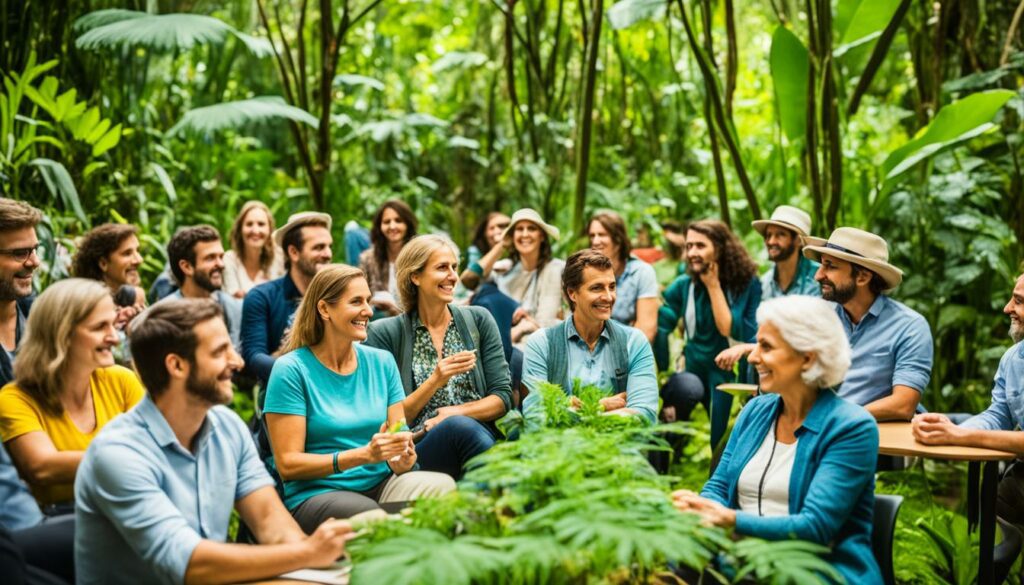
They explore natural resource systems and using clean energy. They’re all about reducing waste and choosing green options. Data from the U.S. EPA is used to highlight important strategies.
These seminars also include eco-learning that can spark big change. Participants get to work on real projects and learn through doing. These efforts aim to turn students into leaders who care deeply about saving the planet.
Well-known names in environmental care notice the value of these educational events. They add depth to the seminar content, helping it address up-to-date environmental issues.
| Natural Resource System | Desired Outcome |
|---|---|
| Air | Sustain clean and healthy air |
| Ecosystems | Protect and restore ecosystem functions, goods, and services |
| Energy | Generate clean energy and use it efficiently |
| Land | Support ecologically sensitive land management and development |
| Materials | Consume less, reduce waste, and shift to environmentally preferable materials |
| Water | Sustain water resources to ensure quality and availability for desired uses |
The seminars also tie into global goals, like the UN’s Sustainable Development Agenda. This links local work with worldwide efforts towards a greener planet.
Altogether, these seminars start important conversations and actions. They prepare the next generation of environmental guardians. By teaching them to care for the Earth, these seminars pave the way for a better, greener future.
Looking ahead, we see the importance of educating young people about the environment. This includes teaching them to protect our planet and to push for green rules through learning. These efforts help make us all more aware of the Earth, inspire us to care, and show us how to live in ways that are good for nature.
Specialists in environmental studies are vital for this. They team up with students, teachers, and school leaders to bring green projects to life. This involves adding green topics to lessons, teaching teachers new green skills, and making schools eco-friendly. They also talk to people about how our health is linked to our environment, raising awareness about nature.
Getting leaders to make better green policies is key too. These experts discuss eco issues with policy-makers, fight for better green lessons, and work with the media to show why learning about the environment is crucial. They also work with those who protect nature, ensuring that decisions about our planet think about the bigger environmental picture.
These green teachers are active outside of classrooms too. They lead classes on saving nature and protecting animals, proving the value of living sustainably. They work with doctors to show how nature can keep us healthy, pushing for more nature in health programmes.
In the UAE, for example, tech colleges are leading great green projects. They’ve changed what and how they teach to support a greener future. Working with local groups, they’ve made campuses more eco-friendly. They’ve built more green spaces and used energy better.
| Stakeholder | Role in Green Education | Example Initiatives |
|---|---|---|
| Environmental Educators | Develop curriculum, facilitate programs, engage in advocacy | Citizen science programs, curriculum integration, professional development |
| Higher Education Institutions | Train next-generation teachers, integrate sustainability into practices | Green campus initiatives, sustainable development seminars, student startups |
| Public and Private Sector Partnerships | Provide experiential learning opportunities, advocate for policy reforms | Local partnerships, sustainable business practices, awareness campaigns |
By focusing on green education, we can prepare young people to tackle environmental problems. This approach helps not only in personal growth but also in working together for a better, green world.
It’s crucial to tackle the obstacles in teaching about biodiversity conservation. Climate change, loss of habitats, pollution, and overuse of resources are big issues. They all reduce the variety of life on Earth.

Teaching climate science in the conservation biology curriculum is key. It helps future generations deal with climate change’s effects. Promoting eco-friendly learning programmes that focus on restoration helps save habitats. Things like rebuilding forests and reefs are vital to stop habitat loss.
| Challenge | Solution |
|---|---|
| Climate Change | Incorporate climate science in educational curricula. |
| Habitat Loss | Promote habitat restoration projects. |
| Pollution | Enhance public awareness and policy advocacy on pollution control. |
| Resource Overexploitation | Foster sustainable practices and consumption. |
Controlling pollution is a must for saving biodiversity. Holding environmental conservation workshops can boost awareness and drive policies to cut down on pollution. Managing resources sustainably is also important. For example, opting for lab-grown meat and vertical farming can help.
Businesses and governments play a huge role in these efforts. By using unsustainable resources, companies risk harm to the environment and their own reputation. Laws that reward conservation are crucial. Education, public awareness, and good policies are all essential in protecting our planet’s biodiversity for the future.
The mixing of traditional ecological knowledge (TEK) with today’s conservation work gives a full look at biodiversity management. Communities that have lived on 4% of U.S. land for generations know a lot about how ecosystems work. Learning from them can make our efforts to protect nature better and stronger.
Native American lands in North America have more wild open spaces than all parks and reserves. This shows how important their traditional knowledge is for saving our planet. They live in biodiverse areas and help keep our world a good place to live.
Teaching both traditional and modern ways of caring for nature helps us see the big picture. We learn a lot from them about all kinds of places, from cold tundras to warm rainforests. This knowledge is very valuable for anyone who wants to save nature.
Traditional knowledge is different from what we learn in schools. It gives a deep, rich insight into how we can protect our planet’s life forms.
Many schools now include traditional ecological knowledge in their science classes. This helps students understand nature better. They see a mix of old and new ways to care for the Earth. It’s great because some traditional practices are even better than what we use today. For example, starting new forests involves using special pioneer plants. These are really important for the Earth, and indigenous people often do this better than we do.
The fight against climate change got a big boost from the Kunming-Montreal Biodiversity Agreement in December 2022. This agreement shows the world is paying more attention to what indigenous people have known for ages. It says that we should all work together to protect nature. Around the world, countries are starting to listen to traditional ways of taking care of the Earth. This shift will help make our planet a better place for everyone.
Bringing together old and new knowledge is helping our nature-saving projects a lot. By working together, we create strong ways to protect the environment. We make sure to include everyone in these efforts. This way, we can take good care of Earth’s many habitats, making life better for everyone.
Policy and governance are key in making green education, wildlife protection classes, and environmental workshops work well. Today, a million species could vanish in just a few decades. So, it’s now very important to push for strong conservation policies.

Governments and big groups must make big plans to help conservation education. They should make laws that put nature lessons in school. Giving money and help for these workshops can make teachers and students really get involved in saving wildlife.
Working together worldwide is also vital. Groups like USAID aim to make big changes to save nature. Their plan links the progress of people with saving diverse habitats. This supports communities to start teaching about nature. Their newer plan talks about the true worth of nature, pushing for ongoing learning about saving Earth’s unique places.
The troubles we face from climate change and vanishing lands are urgent. If we don’t lower our pollution soon, many sea animals may go extinct. This really shows how crucial it is to educate and act now.
Many groups and individuals are needed to help save different species. By joining hands and using plans from groups like the Asian Development Bank, we can teach effectively and save wildlife better.
To wrap up, we need strong policies and rules to boost green education and save nature. This will help us create a strong system to look after our planet in the long run.
Conservation education is vital for saving our planet’s diversity in the long term. It is crucial to measure their effect to make them better and achieve goals. USAID’s “Measuring Impact” project, running from 2012 to 2018, focused on making global conservation more effective.
The project worked on improving how conservation and natural resource management efforts are carried out. It helped by creating thorough analyses, clear change theories, and measurable results.
Metrics used to evaluate these projects include:
These measurements show the real impact of teaching about nature and running conservation courses. For instance, the project sought to make a lasting difference by training experts who work in conservation. It also aimed to make conservation approaches more effective by using solid learning. Additionally, it wanted to show the benefits of protecting nature for all sectors and boost USAID’s role in smart conservation work.
A key to success was using a learning-focused method, like the CLA model suggests. This model lets conservation courses adjust to new facts and needs. It’s a smart way to keep improving how we save the environment.
Using facts to teach saves the environment better. Fair systems, for example, getting advice from experts, help check if what we’re doing really works. The “Measuring Impact” approach, focusing on acting on what’s learned and improving from our mistakes, was praised. It shows that being ready to change and learn more is crucial for these courses.
Also, the “Measuring Impact” project showed how saving nature improves other important areas, like making sure people have enough food. It looked at nine countries to see how better fishing supports global growth.
Keeping these programs effective for the future means always checking and improving them. This loop helps conservation efforts to do the most for the Earth’s wildlife. Keeping this cycle going will help keep our planet’s natural systems strong.
Biodiversity conservation education is key to protecting our planet. It not only makes us aware but also makes us feel responsible for nature. A study in 2023 showed how such education brings together governments, NGOs, communities, and people to work together.
In India, the study found that actions like destroying habitats and polluting are hurting biodiversity. The research used information from different sources. It says we need better ways to teach people about saving nature. A survey in Gunung Mulu National Park found that visitors know more about conserving nature. This is because they have higher education and wealth.
In Malaysia, there’s little public knowledge about saving nature, which slows down efforts. The study uses the KAP framework to see where people lack actions in conserving nature. It also shows how saving nature helps us through services like clean air. We must keep teaching about protecting biodiversity. This way, we and future generations can care for our planet.
It’s about teaching the value and ways to protect Earth’s life variety. This includes teaching green habits, conserving nature, and taking part in conservation projects.
It’s vital as our survival depends on Earth’s diverse life. Understanding why it’s needed helps us make eco-friendly choices and protect our planet.
It teaches us to make choices that don’t harm the planet. By learning about nature, we become prepared to tackle environmental issues for a better future.
The WEEC brings experts together to share knowledge on eco education and development. It aims to improve learning through combining nature education with outdoor experiences.
The Biodiversity Initiative in Washington State shows great success. It focuses on protecting landscapes, monitoring wildlife, and educating people about conservation.
Getting locals involved through education and hands-on programmes is key. This not only helps protect nature but also creates a community that cares for the environment.
It blends practical work, theory, and research, using nature-friendly methods. By promoting learning outside, it makes students truly understand and respect nature.
These events help spread the latest tips for saving biodiversity. They bring together people from various fields to share knowledge and make important decisions for our environment.
One way is by turning school grounds into green spaces. This makes learning about nature very real and encourages kids to care for the planet.
Virtual reality and apps make learning about wildlife fun and interactive. They show the need for protecting animals and nature in a powerful way.
They are crucial for teaching people about balancing growth with protecting our planet. These seminars encourage living in a way that supports both people and the environment.
Laws, funding, and working with other nations can make conservation education stronger. It’s vital that governments and groups help in educating people on how to look after our planet.
By looking at how much people know, what choices they make, and how their actions help nature. Regular checks make sure that education keeps helping to save our planet.